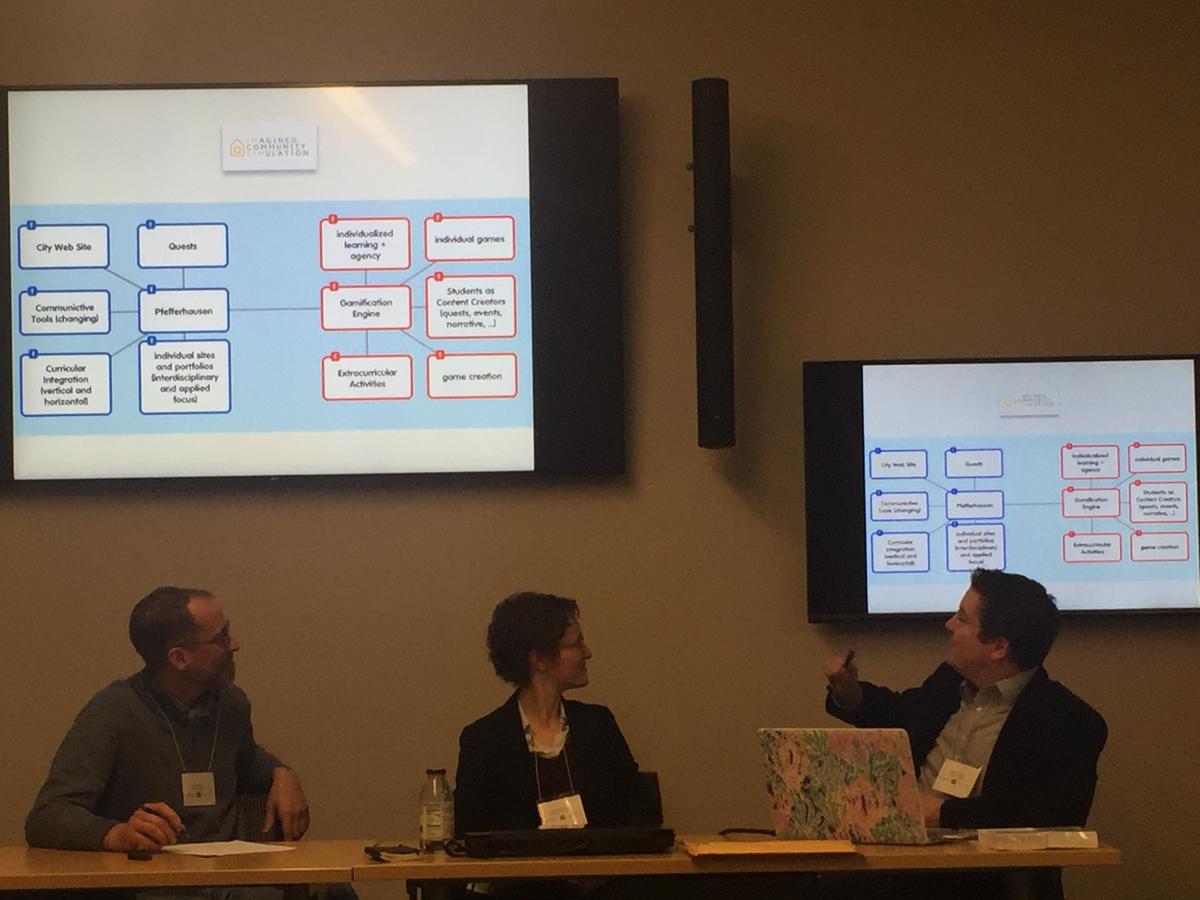Home » News » Resolve to Use Games in the Classroom in 2017
Resolve to Use Games in the Classroom in 2017
Posted by anderc8 on Monday, January 30, 2017 in News, Research Scholar Grants.

Vanderbilt University Graduate Student Melanie Forehand
Written by Melanie Forehand, Vanderbilt University Graduate Student
Lynn Ramey received a Research Scholar Grant of $10,500 to organize a colloquium with Todd Hughes (Center for Second Language Studies) and David Neville (Grinnell College) about creating or modifying immersive environments using video game engines. Participants were invited from both academia and the video game industry to speak about their perspectives on language and culture. As a HASTAC scholar for the Center for Second Language Studies, I attended the colloquium.
You’ve probably heard that inspirational quote about surrounding yourself with people who challenge you and make you better. What if we could extend that same notion to space? Is it possible for us to create spaces that engage our students and help them to understand new information? Panelists at the Immersive Environments Colloquium at held at Vanderbilt University on December 9th and 10th suggested that the answer is yes. During the conference, independent game designers, university faculty members, and software developers showed how their projects are transforming the way students read literature, learn about culture, and practice language skills.
Here are ten tips that I learned from their talks about incorporating immersive environments in the classroom:
- Start small:You don’t have to know how to write code or have extensive experience with using Unity in order to add games to your syllabus. Professor Julie Sykes from the University of Oregon and Professor Jonathon Reinhardt from the University of Arizona have developed a repository of digital games and activities for a variety of languages and levels. https://games2teach.uoregon.edu
- Collaboration is key:It is possible to build your own game, just ask Grinnell College Professor David Neville. He built a game to help his German students distinguish between the accusative and the dative forms. However, many games result from the collaborative team efforts. Consider reaching out to others on your campus with similar interests in gaming. Rebecca Panter from Vanderbilt University recommends using screen sharing and Skype to make game collaborations easy, even from a distance.
- It’s not just video games:You can “gamify” other aspects of your course. Part of what makes video games so entertaining is that you are working towards a reward– if you complete part of the quest, you earn points and move one step closer toward your goal. The same process may be applied to course design. Professor Felix Kronenberg and his colleagues at Rhodes College have created their own online community called Pfefferhausen based on the idea of gamification: http://www.pfefferhausen.org/projectinformation/. As residents of the fictitious town, students in the German courses earn points by contributing to the community. For example, the student citizens create restaurant and cafe websites for the town and design their menus.

- Blogs can be immersive too:Immersive environments can take many forms. French Professor Virginia Scott, for example, has her students write blog posts in which they map scenes from the 17th century novel La Princess de Clèves onto a map from the same time period.
- Be prepared to change how you think about assessment:Most games are built around the idea that you fail at your first attempt and keep trying until you reach your goal. This requires us to think differently about how we assess student work produced through immersive environments. This might mean evaluating a website rather than a term paper, or assigning credit based on completion rather than the correctness of a first attempt.
- Know your hardware limitations:If you choose to use a traditional video game, students will need access to gaming platforms or compatible computers. In addition, if students are using campus computers, they may not be able to save their game progress.
- Games can be analyzed:Even if a game isn’t specifically designed as an educational tool, it can still be used for teaching. Historian Maxime Durand works with Ubisoft to develop the Assassin’s Creed series. He shared that a number of educators are using the video game as an introduction to historical themes and places. Others, such as Professor Lynn Ramey, have used video games to teach medieval culture or to examine the perspective of the game’s narrative.

- Games are more fun in groups:Even games that are designed for one player may be used for group activities. One student might play while another notes unfamiliar vocabulary words. Professor Jonathan de Haan has found that by playing games in groups, students utilize communicative skills such as asking questions and commenting on the other players’ progress.
- Unexpected results:Students may use the program differently from how you had envisioned. Rob Howland developed a Kickstarter-funded immersive game called Influent to teach basic house vocabulary. Based on his player data, players are gaining exposure to a wide variety of vocabulary words, but some of the features that he built into the game have gone largely unused. If there are features in your game that you want to highlight, you may need to provide students with additional guidance or direction.
- Keep an eye out for new developments:A flood of new games enters the market each year and technological advancements allow for existing games to add new features. For example, Professor Mubbasir Kapadia and his students are working on creating programs for computer-assisted authoring of historical narratives. Soon students will be able to create their own storyboards and have narrative scenarios play out before their eyes.
Whether you add a pre-existing game to your syllabus or build your own Pfefferhausen, language and literature students can benefit from the additional practice and context that immersive environments provide.
